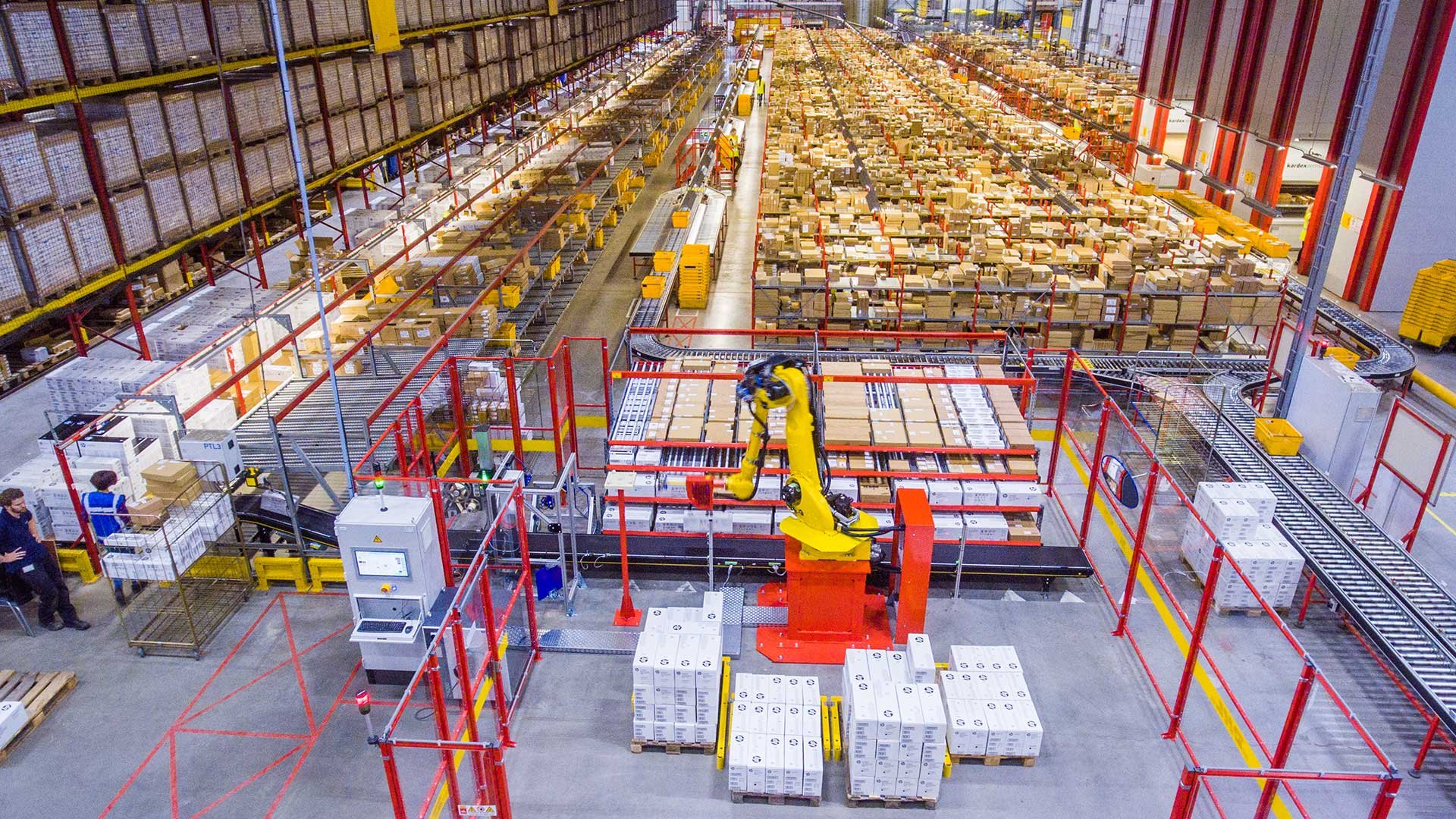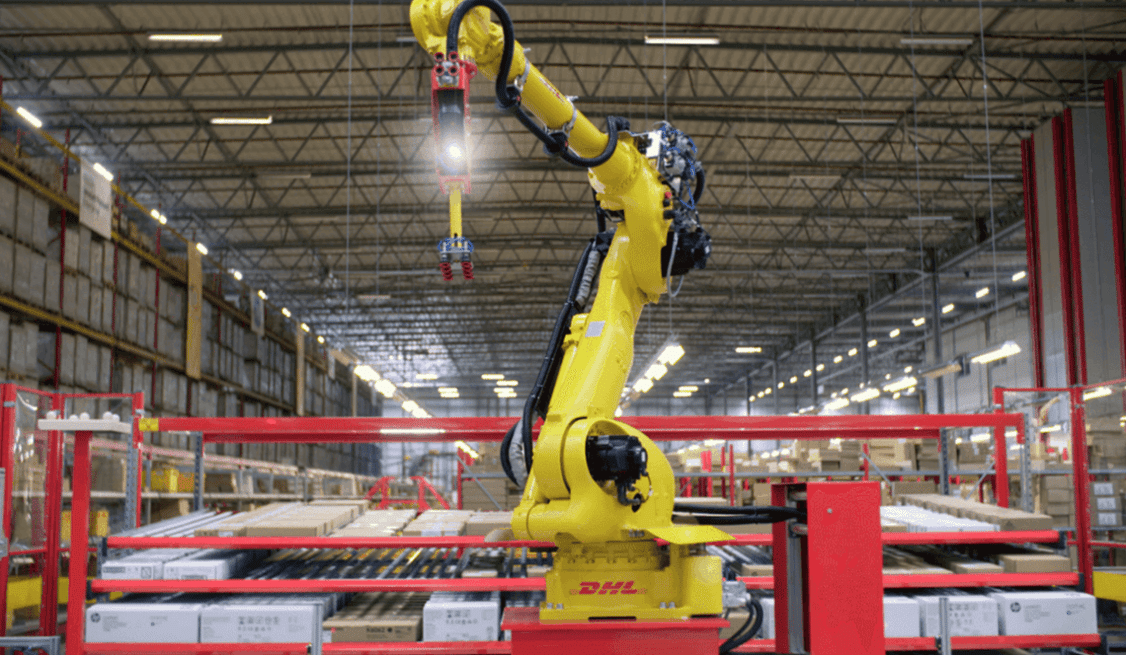
Warehouse
Logistics
e-fulfillment
Material handling
Robot mounting
Zivid One 3D cameras
Motoman MH180-120
Euro Pallets
Flow Racks
Company
DHL
Integration
Robomotive
Application
Warehouse
E-fulfillment
Pick and place
Material handling
Features
Up to 600 picks/hour
Robot mounting
No teaching
Thousands of SKUs
3D camera
Zivid One
Published
6 Apr 2020
Through the robotisation of its warehouses global logistics leader DHL is increasing both the efficiency of its e-commerce operations and the satisfaction of its employees at the same time. For a labour-intensive depalletizing, picking and fulfilment operation, DHL turned to system integrator Robomotive for a flexible solution able to cope with a highly dynamic business environment. The Zivid One 3D color camera played a key role in an advanced robot cell design.
The tasks of depalletizing, picking and order-fulfillment in traditional e-commerce warehouses has traditionally been handled by human operators. The work though is highly repetitive, physically strenuous and prone to the risk of human error. Automation of such high-volume processes not only increases throughput and accuracy, it enables logistics firms to reassign human operators to concentrate on safer, more complex tasks, where they add more value to warehouse operations.
At its warehouse in Beringe, Netherlands, DHL worked with automation system specialist Robomotive to integrate a robotic box-picking cell capable of tackling its most labour-intensive depalletizing, picking and fulfillment operation. Robomotive’s cutting-edge solution proposed an industrial robot arm, vacuum gripper and robot-mounted 3D vision camera to achieve the hand-eye coordination of human operators and an increase in process speed and reliability.
Particularly in automated manufacturing operations handling a relatively small number of components, 3D vision systems involved in comparable bin-picking tasks have traditionally relied on machine learning to be able to identify individual parts. A typical machine learning-based vision system might need access to master data comprising anything from 100 to 1000 CAD file images to be able to teach the robot how to reliably recognise an item and correctly act upon it.
However, in the case of a large scale e-commerce operation handling a multitude of different boxes and parcels and tens of thousands of SKUs (stock keeping units) CAD files are simply not available. A different approach to object recognition was therefore needed for the picking cell.
At the same time the robot cell needed to be capable of delivering the physical reach capability, mechanical lifting capacity and flexibility requirements demanded by the logistics application. It needed to be able to pick anything arriving on palettes and flow racks at a very high rate and on a continuous basis.

Tjalling de Vries
Site Development Manager and Innovation Lead Benelux, DHL
The core of Robomotive’s automated picking cell solution comprises a Zivid One 3D color camera, a Yaskawa Motoman MH180-120 robot with vacuum gripper and an Intel i7 processor-based industrial PC with GPU. Warehouse-wide communication with the cell is assured by a Siemens PLC and Profibus network connection.
The robot arm, customised in yellow to match the DHL brand colors, has a radius reach of 3 m and can lift up to 120 kg. It can pick up any size and shape of box placed at four specified palette locations and up to 50 predefined flow rack positions and delivers it onto a conveyor belt.
To enable the system to achieve the pick-and-place function without CAD file learning, Robomotive developed proprietary object recognition software to process the Zivid camera’s ultra-high resolution 3D image cloud output.
The goal was clear, we’d develop a software that would enable a robot to simply ‘look’ at an object, clearly understand its form and dimensions and move it. In this case the robot’s ‘eyes’ were provided by the Zivid One.
"Over the years we’d tested a lot of different gaming and industrial vision cameras, and for some time had worked with 3D laser triangulation sensors. These though were costly and need a lot of calibration. Based on structured white light projection, the Zivid camera gave us all the 3D point cloud data we needed to very accurately distinguish the wide range of target objects."
Michael Vermeer
CEO of Robomotive
A real-time 3D color camera, the Zivid One captures 3D (xyz), color (RGB) and contrast (C) data on a single sensor chip. Its 3D image acquisition rate is 12 Hz and it outputs vivid 2.3 MPixel high definition 3D images via a USB3.0 port. Housed in an IP65-rated black aluminium casing, the camera is dust and water resistant and shock resistant to a 15 G impact. And measuring just 226mm x 165mm x 86mm, and weighing less than 2kg, it is well-suited to robot arm mounting as Vermeer explains:
It was essential in this application for the machine vision camera to be mobile and directly attached to the robot, and the Zivid One provided all the robustness and physical characteristics we needed. Using multiple static cameras instead, with all the extra calibration and additional cost involved was simply impractical.
While DHL’s warehouse management system understands which SKU is at each defined palette or flow rack position, the robot doesn’t need to. It just goes where it’s told to, determines the presence of boxes and then picks them up one by one and and puts them on the conveyor. A barcode scanner then simply verifies that SKUs match up with that requested.

Regarded as DHL’s first fully automated e-commerce order picking cell, the robotic system at the heart of the company’s Beringe warehouse already achieves 400 picks per hour, and this is expected to increase to 600 picks per hour through further system optimisation.
The ultra-high resolution of the 3D images provided by the Zivid One machine vision camera has provided the level of detail the robot needs to be able to clearly locate and differentiate one box from another on palettes and flow racks at multiple locations.
The combination of high quality 3D image capture and Robomotive’s custom software algorithms has removed the need for CAD files and machine learning and has enabled a more flexible geometry-driven approach to machine vision integration. One that does not rely on the precise alignment and placement of boxes.
The highly adaptive nature of the robot cell means we don’t need to be continually reprogramming the system to accommodate new product introductions. This allows us to react even more quickly to changes in market trends and consumer demand and to maintain the highest possible level of customer service.
Tjalling de Vries
Site Development Manager and Innovation Lead Benelux, DHL
Operating during regular day shifts, the robot cell is expected to achieve a payback period of around three years, although its inherent ability to operate continuously 24/7 could mean a far shorter timescale. The deployment of the same robot on a linear track is also a consideration for the future, enabling it to extend its pick front and reach even more boxes on more palettes and flow racks.
Robomotive gives eyes to robots to give you a helping hand. With these inexhaustible and versatile mechanical hands, we help you lower the operational costs of your material handling processes.
Zivid brings
Gjerdrums
N-0484, Oslo
Norway